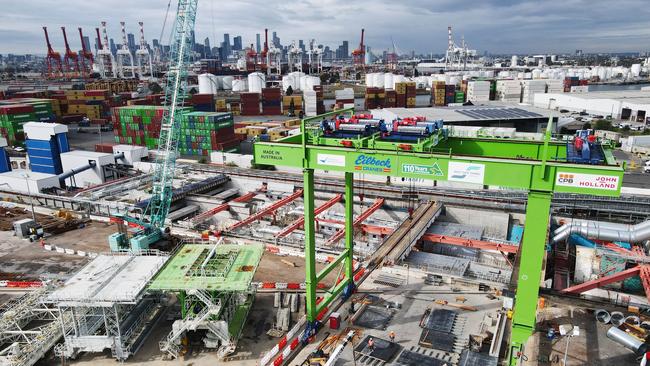‘Noxious cocktail’ puts build boom at risk
The value of public infrastructure spending will hit $285bn in 2023, a surge in construction and engineering work that will eclipse the mining investment boom of 2015.

The value of public infrastructure spending will hit $285bn in 2023, a surge in construction and engineering work that will eclipse the mining investment boom of 2015.
Deloitte Access Economics’ quarterly investment monitor reveals the value of government-funded infrastructure projects underway has increased from a low of $131bn in early 2015 to $202bn in late 2021 – a gain of more than 50 per cent.
Public investment is set to grow by a further 11 per cent this financial year after lifting by 5.9 per cent in the last, before plateauing in 2022-23 and declining in 2023-24, Deloitte estimates.
Private business investment will grow by 4.6 per cent in 2021-22, and 7.9 per cent in 2022-23, Deloitte said – adding an estimated 1.4 per cent to real GDP over the two financial years.
Public investment will add a smaller 0.5 per cent to national output in this financial year, and nothing in the next.
While a boon for companies and workers, the looming pipeline of extra work will further stretch the country’s capacity to deliver on these projects, with Covid supply blockages amplifying a lack of skilled labour.
Deloitte Access Economics partner Stephen Smith said “put simply, a lack of workers and materials is a noxious cocktail for the construction industry. And with a record amount of infrastructure work set to be completed – not to mention a large pipeline of residential construction activity – it will be a stretch for contractors to deliver projects on-time and on-budget”.
The challenge for authorities and private businesses to deliver major construction work close to budget was highlighted by Infrastructure Australia’s recent National Study on Infrastructure Risk. That report estimated a $90bn in cost overruns in the $218bn in projects it counted over the coming five years.
This was a typical result of the “optimism bias” that results in bidders for projects to typically underquote by 30 per cent, IA said.
Deloitte identified several upward cost revisions during the three months to September across major public and private projects.
They included: Transurban’s West Gate Tunnel in Melbourne, expected to cost $10bn from $6.bn; Transgrid’s Humelink project – a power line that will connect Wagga Wagga, Bannaby and Maraglewhich in NSW – set to cost $3.3bn rather than $2.1bn; and the first stage of the Coomera Connector road on the Gold Coast, with a budget now estimated at $2.1bn from $1.5bn.
The massive surge in fiscal commitments compares to a much more modest $66bn worth of non-infrastructure investment projects under construction, Deloitte said.
Mr Smith said firms had grown less pessimistic as the Delta lockdowns were lifted. “As businesses continue to acclimatise to the new Covid normal, their attention is turning from external risks to internal ones,” he said.
“This includes securing and retaining key talent, executing strategies and implementing new technologies.”
The Deloitte Access Economics partner said the pandemic had changed the character of future investment.
“The Covid period has also dramatically changed where, when and how people work.
“This is likely to shape the types of investments required over the coming decades,’’ Mr Smith said.
“The proportion of people working from home is expected to remain permanently above pre-Covid levels, with flow-on effects for investment in transport networks and our CBDs.
“With restrictions now easing, the pace of the business investment recovery will depend on levels of certainty provided by governments.
“Ongoing state border restrictions, quarantine requirements for travellers and the threat of snap-lockdowns present a challenging backdrop for new investment.”




To join the conversation, please log in. Don't have an account? Register
Join the conversation, you are commenting as Logout